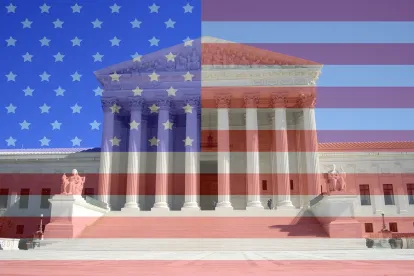On Tuesday, the U.S. Supreme Court issued two important patent law opinions that relate to the inter partes review procedure introduced by the America Invents Act: Oil States Energy Servs., LLC v. Greene’s Energy Grp., LLC, which upholds the constitutionality of inter partes review, and SAS Institute, Inc. v. Iancu, which requires the Patent Trial and Appeal Board to adjudicate the validity all patent claims challenged in a petition for inter partes review if the Board decides to adjudicate the validity of any claim challenged in that petition. Yesterday, the PTO issued a memo describing how pending trials will be conducted and how new petitions will be addressed in light of SAS Institute, but important questions remain.
We first covered the Supreme Court’s grant of certiorari in Oil States Energy Servs., LLC v. Greene’s Energy Grp., LLC, 137 S. Ct. 2239 (2017) in June 2017. The petitioner asked the Court whether inter partes review—an adversarial procedure introduced by the America Invents Act in late 2012 that allows the Patent Trial and Appeal Board, an adjudicatory body within the Patent and Trademark Office (PTO), to determine the validity of issued patents—violates the Constitution by allowing a non-Article III forum, without a jury, to extinguish private property rights. We also covered the oral argument held before the Court on November 27, 2017. The case drew a lot of attention from stakeholders across the spectrum, from industry heavy-weights such as Apple, GE, and Google who support inter partes review, to small inventors, venture capitalists, and law professors, who question its constitutionality.
Earlier this week, the Supreme Court held that inter partes review does not violate Article III or the Seventh Amendment of the U.S. Constitution. Writing for the 7-2 majority, Justice Clarence Thomas rejected Oil States’s twin arguments that patents are private property rights and that they can be extinguished only by an Article III court. He explained that patents are a grant of a “public franchise” and that, as such, “[i]nter partes review falls squarely within the public-rights doctrine.” Justice Thomas went on to explain that “[i]nter partes review is simply a reconsideration of [the] grant” of the patent, and that “Congress has permissibly reserved the PTO’s authority to conduct that reconsideration.” Accordingly, the Patent Trial and Appeal Board is not prohibited from reviewing that grant even though it is not an Article III court. Nor is the Board exercising judicial power even though the inter partes review procedure bears some similarities to district court litigation.
Although the Court determined that inter partes review is constitutional, it took issue with how such reviews are conducted in SAS Institute, Inc. v. Iancu, the second patent law opinion the Court issued on Tuesday. A petition for inter partes review must specify the claims of the patent being challenged and state why the challenge is likely to succeed. The PTO Director must then decide whether to grant the petition and institute a trial to adjudicate the validity of the challenged claims. Petitioner SAS Institute asked the Court to determine whether the Board is required to decide the validity of every patent claim challenged in a petition for inter partes review when the Board decides to institute review of at least one of the challenged claims. Until the Court issued its opinion on Tuesday, it was standard practice for the Director to institute trial only with respect to a subset of the claims challenged in a petition. That practice is now prohibited.
The Court held that “[w]hen the Patent Office institutes an inter partes review, it must decide the patentability of all of the claims the petitioner has challenged.” Writing for the 5-4 majority, Justice Gorsuch explained that the governing statute, 35 U.S.C. §318(a), provided that at the end of the inter partes review proceeding, the Board “shall issue a final written decision with respect to the patentability of any patent claim challenged by the petitioner.” He characterized the directive of §318(a) as “both mandatory and comprehensive,” and noted that the word “shall” implies a nondiscretionary duty.
Yesterday, the PTO issued a memo describing how the Board will handle both pending trials and new petitions for review in light of SAS Institute. The memo also noted that the Board will “host a ‘Chat with the Chief’ webinar on Monday, April 30, 2018, from noon to 1 pm ET to discuss the SAS decision, its impacts on AIA trial proceedings, and answer questions.”
With respect to pending trials that were instituted on fewer than all challenged claims, “the panel may issue an order supplementing the institution decision to institute on all challenges raised in the petition.” In such a case, “the panel may take further action to manage the trial proceeding, including, for example, permitting additional time, briefing, discovery, and/or oral argument, depending on various circumstances and the stage of the proceeding.” The panel may also extend a case that is close to the end of the 12-month statutory deadline “if required to afford all parties a full and fair opportunity to be heard. In such cases, the panel may adjust other procedural dates as necessary.” The final written decision in any pending trials will address “all patent claims challenged by the petitioner and all new claims added through the amendment process.”
Going forward, the Board will abide by the Court’s opinion and “will institute as to all claims or none.” If it institutes a trial, it “will institute on all challenges raised in the petition.”
The memo’s reference to “all challenges raised in the petition” suggests that the Board will not only address all claims challenged in the petition, as SAS Institute requires, but that it will also address each of the grounds on which each claim is challenged. SAS Institute is silent as to whether the Board must address not just each challenged claim if it institutes trial, but also each of the grounds on which each claim is challenged. If the Board does address every ground on which a claim is challenged, this will have a dramatic impact on district court litigation, and on the strategic considerations for bringing petitions for inter partes review in the first instance because petitioners are estopped from raising in district court any ground addressed by the Board in a final written decision. Such a change will likely incentivize petitioners not only to present their best art and their best arguments with respect to each claim they challenge, but to challenge only those claims they really believe they can prove to be invalid, and then only on grounds they believe they can prove are invalidating.
Still, many questions remain about how SAS Institute will impact patent practice before the Board and beyond. Some commentators have speculated that the Board will issue much shorter—even one-word—institution decisions that indicate review is either “instituted” or “denied,” rather than the lengthy explanatory decisions it now issues. Shorter decisions will mean that petitioners and patent owners will get less (and possibly no) insight into what the Board considers to be the strengths and weaknesses of the petition, which in turn will make preparing for the trial more difficult and more costly. At the same time, we are likely to see much longer and more comprehensive final written decisions because the decisions will have to address claims, prior art references, and arguments that the Board has to date been able to ignore.
Commentators have also suggested that to manage its workload the Board will issue fewer decisions instituting review. The Board’s decision to institute review is discretionary and non-appealable. Now that the Board will have to adjudicate the validity of all the claims challenged in a petition if it decides to review the validity of any of those claims, it may decide not to institute review if it determines that only a small subset of the challenged claims meet the “reasonable likelihood” standard of establishing unpatentability—the threshold requirement for instituting review.
It is too early to say for certain what implications SAS Institute will have on patent practice, but what is clear is that the Board’s response to the opinion will shape the strategic considerations of petitioners and patent owners alike as the inter partes review procedure continues to evolve in the years to come.






 />i
/>i
